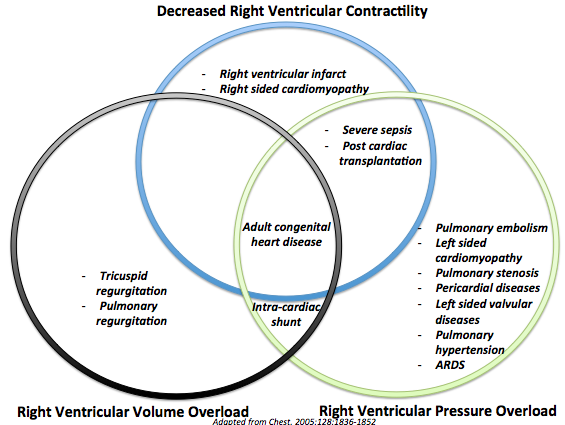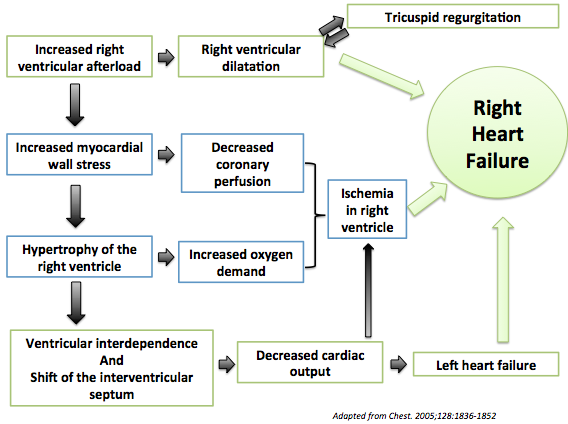Right heart failure pathophysiology
|
Right heart failure Microchapters |
|
Diagnosis |
|---|
|
Treatment |
|
Case Studies |
|
Right heart failure pathophysiology On the Web |
|
American Roentgen Ray Society Images of Right heart failure pathophysiology |
|
Risk calculators and risk factors for Right heart failure pathophysiology |
Editor-In-Chief: C. Michael Gibson, M.S., M.D. [1];Associate Editor(s)-in-Chief: Rim Halaby; Jad Z Al Danaf
Overview
The pathophysiological processes underlying right heart failure can be divided broadly into three: decreased right ventricular contractility, right ventricular pressure overload, right ventricular volume overload [1]. Right ventricular hypertrophy or RVH is the predominant change in chronic cor pulmonale although in acute cases dilation dominates. Both hypertrophy and dilatation are the result of increased right ventricular pressure.
Pathophysiology
- The pathophysiological processes underlying right heart failure can be divided broadly into three:
- Decreased right ventricular contractility
- Right ventricular pressure overload
- Right ventricular volume overload [1]
Shown below is an image illustrating the underlying etiologies of heart failure classified according to their pathological basis.

- The right ventricle tries to adapt acutely by dilatation and chronically by hypertrophy. Whether dilatation or hypertrophy occur, right heart failure gets further exacerbated as a result of these adaptive mechanisms.
Shown below is an image illustrating the vicious cycle of right heart failure as a consequence of the acute and chronic compensation of the heart.

Acute Right Ventricular Dilatation
- Dilation is essentially a stretching of the ventricles, the immediate result of increasing the pressure in an elastic container.
- When the RV dilates secondary to any injury to the right ventricular myocardium, most notably pressure overload, the tricuspid annulus dilates leading to tricuspid regurgitation and further worsening of RV function thus falling into a vicious cycle of RV dilatation and failure.
- In addition, due to the restrictive effect of an intact pericardium on the RV, the volume overload in the RV is accommodated by a decrease in LV volume caused by bulging of the inter-ventricular septum into the LV cavity thus decreasing its filling capacity. This phenomenon is known as ventricular interdependence. Then as the LV fails, the cardiac output decreases and the systemic and coronary perfusion pressures decrease and further compromise RV function.[1]
- In severe cases of RV failure, impaired organ perfusion leading to subsequent organ failure will result from increase in venous pressures and decrease in arterial perfusion pressures. Thus, unless the RV is unloaded, the above described vicious cycles will persist leading to worsening of RV function, multiorgan failure and eventually death.
Chronic Right Ventricular Hypertrophy
- Ventricular hypertrophy is an adaptive response to a long-term increase in pressure. Additional muscle grows to allow for the increased contractile force required to move the blood against greater resistance.
- Since the RV accommodates a relatively large volume load as a preload, according to the Frank-Starling mechanism, this increase in preload is transmitted into increase in myocardial contractility to maintain stroke volume and eventually in right ventricular hypertrophy. However this occurs on the expense of an increase in RV wall stress that increases oxygen demand. Eventually, these factors will cause a decrease in RV blood supply during the peak times of myocardial oxygen demand leading to ischemia and worsening of RV function.
- Two examples of chronic pressure overload states that are relatively well tolerated by the right ventricle are:
- Eisenmenger syndrome
- Congenital pulmonary stenosis[2]
Right Heart Failure Secondary to Left Heart Failure
The following sequence of events lead to right heart failure secondary to left heart failure:
- Increase in pulmonary venous and arterial pressures as a protective mechanism result in pulmonary edema, thus increasing RV afterload.
- Myocardial ischemia involving both ventricles, same as concomitant culprit coronary lesions.
- Left systolic dysfunction will impair coronary blood flow in the right coronary artery, thus compromising blood supply to RV myocardium.
- Similarly, intrinsic myocardial pathology (cardiomyopathy) involves both ventricles.
- Inter-ventricular septal dysfunction secondary to ischemia, hypertrophy or cardiomyopathy leads to ventricular interdependence.
- Dilatation of the LV will cause a decrease in the diastolic filling capacity of the RV, in the setting of an intact pericardium.[3]
Cor pulmonale
- In order for the right heart failure to be classified as cor pulmonale, its underlying cause must originate in the pulmonary circulation system. In fact, cor pulmonale is a complication of pulmonary hypertension associated with diseases of the:
- Lungs
- COPD is the most common cause of cor pulmonale.
- Pulmonary vasculature.
- Idiopathic pulmonary hypertension.
- Upper airway.
- Abnormality in the ventilatory drive.
- Chest wall and thoracic cage abnormalities[4].
- Lungs
- When these diseases are present, hypoxia results. Hypoxic pulmonary vasoconstriction is the major contributor to cor pulmonale. Pulmonary hypertension and subsequent increase in right heart load result from hypoxic vasoconstriction. Hence, the heart tries to adapt by dilatation and/or hypertrophy leading to further right heart failure.[5]
- Other pathophysiologic mechanisms leading to pulmonary arterial hypertension and cor pulmonale:
- Hypoxic pulmonary vasoconstriction.
- Compression of the pulmonary vasculature by lymph nodes or tumors.
- Anatomic changes in vascularization of the lung.
- Increased blood viscosity (e.g. polycythemia vera[6]).
- Increased volume overload of the right ventricle (e.g. Atrial septal defect).
- Chronic hypoventialtion of the lung due to mechanical defects (e.g. diaphragmatic paralysis).
Nutmeg Liver
- As a result of right ventricular failure, blood backups up into the system venous system, including the hepatic vein. Chronic congestion in the centrilobular region of the liver leads to hypoxia and fatty changes of more peripheral hepatocytes, leading to what's known as nutmeg liver.
References
- ↑ 1.0 1.1 1.2 Piazza G, Goldhaber SZ (2005). "The acutely decompensated right ventricle: pathways for diagnosis and management". Chest. 128 (3): 1836–52. doi:10.1378/chest.128.3.1836. PMID 16162794.
- ↑ Davlouros PA, Niwa K, Webb G, Gatzoulis MA. The right ventricle in congenital heart disease. Heart. 2006;92(suppl 1):i27–i38. Chin KM, Kim NH, Rubin LJ. The right ventricle in pulmonary hypertension. Coron Artery Dis. 2005;16:13–18.
- ↑ Voelkel N.F., Quaife R.A., Leinwand L.A. et al. Right Ventricular Function and Failure : Report of a National Heart, Lung, and Blood Institute Working Group on Cellular and Molecular Mechanisms of Right Heart Failure. Circulation. 2006;114:1883-1891
- ↑ Budev MM, Arroliga AC, Wiedemann HP, Matthay RA (2003). "Cor pulmonale: an overview". Semin Respir Crit Care Med. 24 (3): 233–44. doi:10.1055/s-2003-41105. PMID 16088545.
- ↑ Rasche K, Orth M, Duchna HW (2006). "[Sequels of lung diseases on cardiac function]". Med Klin (Munich). 101 Suppl 1: 44–6. PMID 16802518.
- ↑ Nand S, Orfei E (1994). "Pulmonary hypertension in polycythemia vera". Am J Hematol. 47 (3): 242–4. PMID 7942794.